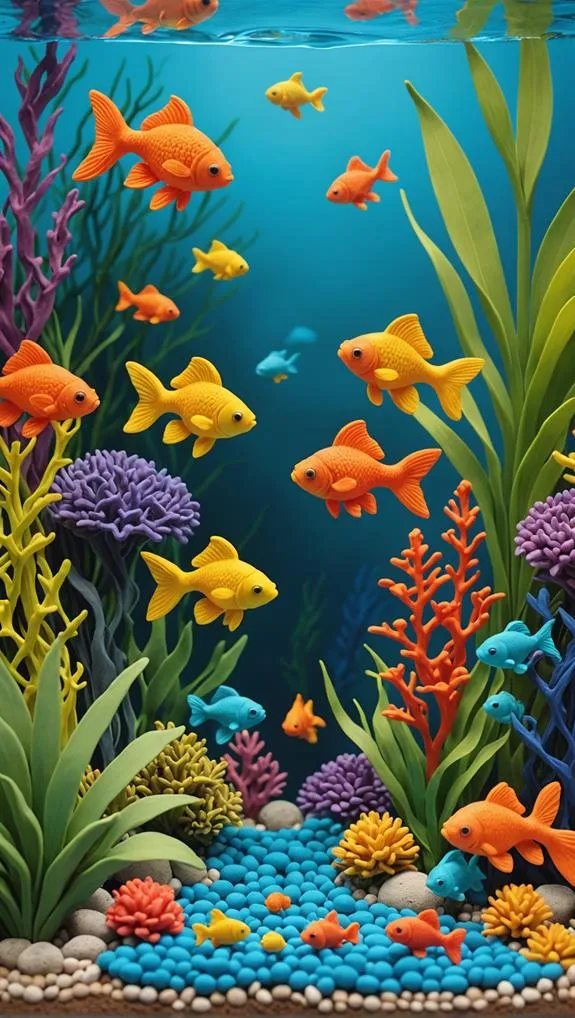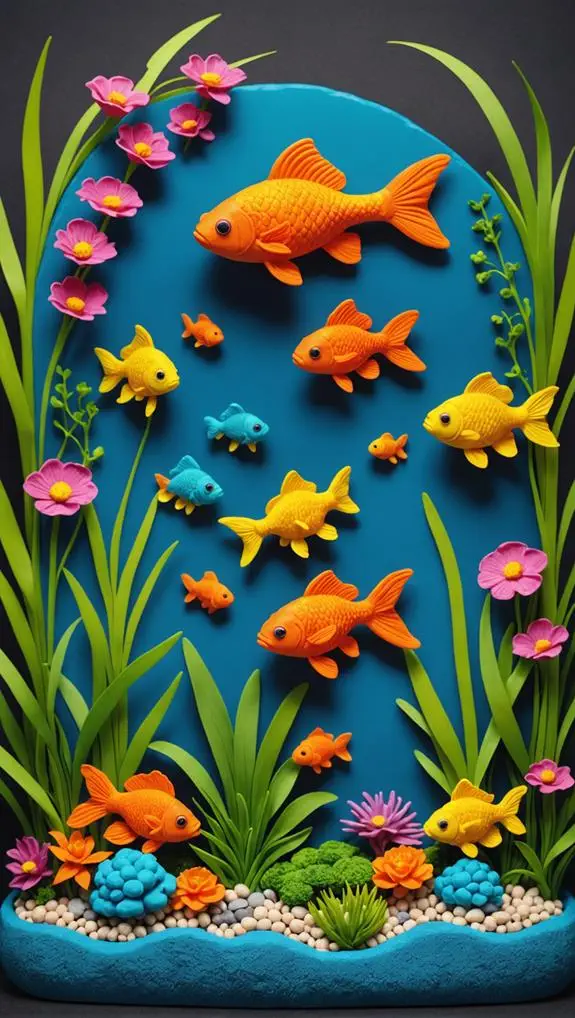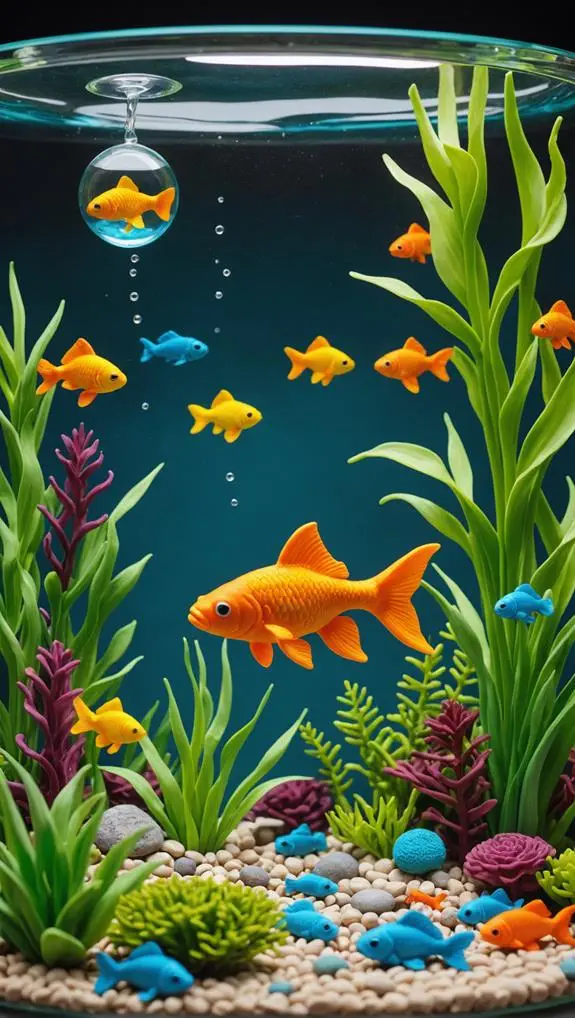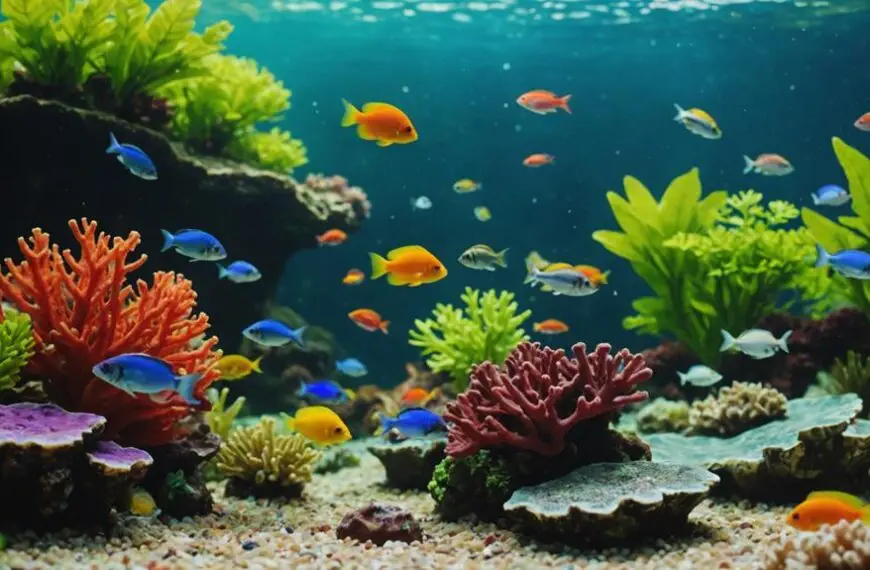To keep your goldfish healthy, focus on a balanced diet, which is key to their happiness! High-quality pellets should make up a big part of their meals—aim for around 30% protein for adults and 35% for juveniles. Toss in some dry flakes, live treats like brine shrimp, and frozen foods to mix things up. Be mindful not to overfeed; portions should vanish in 3-5 minutes. And, of course, don't forget to check their behavior and poop—yep, fish bowel movements tell a tale! Stick around, and you'll discover even more tips to keep your finned friend swimming strong!
Contents
Importance of a Balanced Diet
Maintaining a balanced diet for your goldfish is crucial for their overall health and longevity. Just like us, goldfish need the right mix of nutrients to thrive. You'll want to focus on high-quality pellets, which should make up a significant part of their goldfish food. Aim for a protein level around 30% for adults and 35% for juveniles.
Remember, variety is always key! Along with a diverse diet, consider incorporating other beginner-friendly fish to enhance the tank ecosystem and provide a stimulating environment. Mix in some frozen treats like bloodworms and even veggies like peas to keep their meals exciting and digestible.
Be careful not to overfeed. It's tempting to spoil them, but too much food can lead to health issues and murky water. A good rule of thumb? Offer portions that can be consumed within 3-5 minutes.
Also, consider sinking pellets over floating ones, especially for fancy goldfish. Their unique shapes can make digestion tricky, and sinking pellets are easier for them.
Keep an eye on your goldfish's behavior. If you notice abnormal feces or bulging bellies, it might be time to reassess their diet. By giving your goldfish a balanced diet, you're setting them up for a happy, healthy life!
Types of Goldfish Food
When it comes to feeding your goldfish, you'll find a whole buffet of options to choose from.
You've got everything from dry flakes and pellets to live treats like brine shrimp that make your fish feel like they're dining at a five-star restaurant.
Just remember, it's all about striking that perfect balance to keep your finned friends happy and healthy!
Types of Food
Goldfish thrive on a diverse diet, so it's important to understand the various types of food available to meet their nutritional needs. You'll find that goldfish food comes in several forms, including dry food, live food, frozen, and freeze-dried options. Each type has its own benefits.
Dry food, like flake food and pellets, is common and easy to store. Fancy goldfish often prefer sinking food, which helps with digestion.
On the other hand, live food, such as brine shrimp or worms, packs a high protein punch that's great for growth and breeding. Just remember to gut-load it first for added nutrition!
Frozen and freeze-dried foods are also excellent choices. They keep their nutritional value and make feeding time a breeze.
But don't stop there! A varied diet is crucial for your goldfish's health. No single food can provide everything they need, so mix in fresh veggies and occasional treats to keep them happy.
After all, who doesn't love a little variety? By offering a balanced diet, you'll ensure your goldfish thrive and bring joy to your aquarium for years to come!
Feeding Techniques
Understanding the right feeding techniques is crucial for keeping your goldfish healthy and happy. When it comes to goldfish food, you've got plenty of options! For fancy goldfish, sinking small pellets are your best bet. They help prevent buoyancy issues, so your little swimmer can enjoy a stress-free meal.
Singletail goldfish, on the other hand, can munch on floating food without worry.
Dried food, like spirulina flakes or Bug Bites, is packed with vitamins and minerals. Just make sure to choose high-quality options that minimize fillers.
Live foods, such as gut-loaded brine shrimp and bloodworms, are fantastic protein sources that stimulate natural feeding behaviors.
Now, you might wonder, how often should you feed your goldfish? A good rule of thumb is to feed them a couple of times a day, only as much as they can eat in a few minutes.
Don't forget to spice things up with treats like peas or zucchini! This variety not only keeps your goldfish entertained but also boosts their health.
With these feeding techniques, you'll ensure your goldfish thrive in a vibrant, healthy environment.
Feeding Frequency and Practices

When it comes to feeding your goldfish, timing and portions matter more than you might think!
You should aim to feed them small amounts two to three times a day, adjusting based on water temperature.
Keeping an eye on their eating habits not only helps you know when they're hungry but also lets you show off your goldfish parenting skills—because who doesn't want to be that cool goldfish owner?
Daily Feeding Guidelines
For optimal health, it's important to establish a consistent feeding routine for your goldfish. When it comes to how often you should feed them, keep in mind that if the water temperature is below 70°F, feeding them once daily is best. However, if it's warmer, you can increase that to twice a day. Just remember, goldfish have sensitive digestive systems, so small amounts of good quality food are ideal.
A solid feeding schedule helps reduce stress for your fish and allows you to monitor their eating habits. Offer food in small portions over 3-5 minutes, and keep an eye on any uneaten food. Quickly remove anything that's left behind to maintain water quality and keep your aquarium from turning into a science experiment.
Aim for portions that can be consumed in about 5-6 minutes—this helps with portion control and prevents obesity.
Establishing a routine not only benefits your goldfish but also gives you peace of mind, knowing you're doing your best to care for them. After all, happy goldfish make for a happy aquarium!
Portion Control Techniques
Establishing portion control is key to maintaining your goldfish's health and ensuring a clean aquarium. To keep your fish happy and thriving, feed your goldfish small amounts, 2-3 times daily, allowing them to finish their meal in about 5-6 minutes. This prevents overfeeding—a common problem that can lead to poor water quality.
If your water temperature dips below 70°F (21°C), just one meal a day is enough. However, when it's warmer, two feedings are ideal to match those increased metabolic rates.
Keep an eye on your goldfish's eating habits; if there's leftover food, it's time to adjust your portions.
Setting a consistent feeding schedule helps your goldfish anticipate meal times, reducing stress and promoting better eating behaviors.
Plus, introducing a routine of varying food types can keep things exciting for them, encouraging natural foraging instincts while ensuring balanced nutrition.
Signs of Overfeeding
Over time, you might notice certain signs that indicate your goldfish is being overfed. If you see signs of obesity, like a wider midsection or a bulging belly, it's a red flag. Your goldfish shouldn't look like it just came from a buffet!
You may also observe a lack of appetite or decreased food-seeking behavior, which can signal serious health issues.
Watch for abnormal swimming behavior, too. If your goldfish is floating at the surface or sinking to the bottom, it could be struggling with buoyancy problems due to overfeeding.
Keep an eye on the tank water; the consistency of your goldfish's feces can tell you a lot. Long, stringy waste often means digestive distress from too much food.
Regular health checks and close observation of their feeding habits are crucial. If you catch these signs early, you can make adjustments that help your goldfish thrive.
Nutritional Requirements by Goldfish Type

Understanding the nutritional needs of your goldfish is crucial for their overall health and vitality. Different types of goldfish have unique dietary requirements, so it's essential to get it right.
Singletail goldfish can handle a higher protein diet, with adults needing about 30% protein and juveniles around 35%. They're like the all-stars of the goldfish world with their robust digestive system!
On the other hand, fancy goldfish require a bit more care. Their compact bodies can lead to digestive issues, so opting for sinking pellets instead of floating food is a smart move. Overfeeding these little guys can cause serious health issues, like blockages, which is the last thing you want.
No matter the type, all goldfish are omnivores and thrive on a varied diet. Incorporating high-quality pellets, frozen foods like bloodworms, and fresh vegetables such as peas ensures they get the nutrients they need.
Tailoring your feeding practices based on your goldfish's specific needs is key. With a bit of attention and love, you can help your goldfish live a long, healthy life filled with joy and wiggles!
Best Practices for Food Storage
Proper food storage is vital for maintaining the health of your goldfish. To keep their fish food fresh and nutritious, always store it in sealed containers placed in a cool, dry spot. This helps prevent moisture from sneaking in and ruining the nutritional quality.
Remember, the vitamin content in fish food can drop significantly within just a few months, so think of it as a ticking clock! Additionally, ensuring that your aquarium water quality is consistently monitored can complement your goldfish's diet and overall health regular monitoring of water parameters.
Another tip? Keep the food in the dark. Light can degrade essential nutrients, so a cupboard or pantry is perfect. If you want to go the extra mile, consider storing high-quality pellets in the refrigerator. This can extend their freshness, making your goldfish even happier!
When choosing food, look for a guaranteed analysis statement on the packaging. This ensures the quality and proper ingredient ratios for goldfish diets.
Speaking of options, pellets are generally better than flakes. They spoil less quickly and help reduce the risk of your goldfish gulping in air, which can lead to digestive issues. With these best practices, you'll be well on your way to serving your goldfish the best meals possible!
Monitoring Fish Health and Growth

Monitoring your goldfish's health and growth is essential for ensuring they thrive in your care. It's not just about feeding them; it's about understanding their needs. Regular health checks are key! Keep an eye on their behavior—if they seem sluggish or lose their appetite, you might need to adjust your feeding practices.
Maintaining optimal water parameters, such as pH levels and ammonia concentrations, is also crucial for their well-being and can prevent stress and health issues in your fish pH levels and ammonia concentrations.
Using a growth chart can help you track their size at different ages. Remember, adult goldfish can be about 2 inches longer than you might expect! If you notice signs of stunted growth, it's time to investigate. This could indicate poor care or suboptimal conditions, which might require immediate attention.
Don't forget to observe their feces! Transparent feces could mean they're not getting enough food, while excessive trailing feces might mean you're overfeeding.
And, let's not overlook the importance of water changes; clean water is vital for your fish's health. By ensuring your goldfish has dietary sufficiency, you're not just keeping them alive; you're ensuring they flourish.
Frequently Asked Questions
What Food Should I Feed My Goldfish?
When you're goldfish feeding, use high-quality pellets, freeze-dried options, and live food. Incorporate vegetable treats for dietary variety. Adjust portion sizes and feeding frequency based on their growth stages to ensure proper nutrition.
What Does a Goldfish Need to Be Healthy?
To keep your goldfish healthy, maintain optimal water quality and temperature control, provide adequate tank size, ensure a reliable filtration system, promote social interaction, reduce stress, and maintain proper lighting conditions for disease prevention.
How Do I Make My Goldfish Healthier?
To make your goldfish healthier, maintain optimal water quality, control temperature, and choose compatible tank mates. Implement a consistent feeding schedule, enrich their habitat, and practice disease prevention for stress reduction and successful breeding.
What Are the Nutritional Requirements for Goldfish?
Imagine a chef crafting a feast: for your goldfish, focus on protein sources, vegetable supplements, and a balanced carbohydrate diet. Ensure vitamin enrichment, meet mineral needs, and vary their meals to support growth stages efficiently.
Final Thoughts
In the grand aquarium of life, your goldfish deserves the best care you can offer. By feeding them a balanced diet and keeping an eye on their health, you're not just filling their bowl—you're nurturing their vibrant spirit. Just like a garden flourishes with the right nutrients, your fish will thrive and bring joy to your home. So, let's make every meal count and watch those little swimmers sparkle like treasures in the water!












